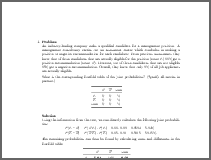fourfold2: Fourfold Table (Flexible Formatting)
fourfold2An industry-leading company seeks a qualified candidate for a management position. A management consultancy carries out an assessment center which concludes in making a positive or negative recommendation for each candidate: From previous assessments they know that of those candidates that are actually eligible for the position (event \(E\)) \(66\%\) get a positive recommendation (event \(R\)). However, out of those candidates that are not eligible \(65\%\) get a negative recommendation. Overall, they know that only \(9\%\) of all job applicants are actually eligible.
What is the corresponding fourfold table of the joint probabilities? (Specify all entries in percent.)
| \(R\) | \(\overline{R}\) | sum | |
|---|---|---|---|
| \(E\) | % | % | % |
| \(\overline{E}\) | % | % | % |
| sum | % | % | % |
Using the information from the text, we can directly calculate the following joint probabilities: \[ \begin{aligned} P(E \cap R) & = P(R | E) \cdot P(E) = 0.66 \cdot 0.09 = 0.0594 = 5.94\%\\ P(\overline{E} \cap \overline{R}) & = P(\overline{R} | \overline{E}) \cdot P(\overline{E}) = 0.65 \cdot 0.91 = 0.5915 = 59.15\%. \end{aligned} \] The remaining probabilities can then be found by calculating sums and differences in the fourfold table:
| \(R\) | \(\overline{R}\) | sum | |
|---|---|---|---|
| \(E\) | 5.94 | 3.06 | 9.00 |
| \(\overline{E}\) | 31.85 | 59.15 | 91.00 |
| sum | 37.79 | 62.21 | 100.00 |
- \(P(E \cap R) = 5.94\%\)
- \(P(\overline{E} \cap R) = 31.85\%\)
- \(P(E \cap \overline{R}) = 3.06\%\)
- \(P(\overline{E} \cap \overline{R}) = 59.15\%\)
- \(P(R) = 37.79\%\)
- \(P(\overline{R}) = 62.21\%\)
- \(P(E) = 9.00\%\)
- \(P(\overline{E}) = 91.00\%\)
- \(P(\Omega) = 100.00\%\)
An industry-leading company seeks a qualified candidate for a management position. A management consultancy carries out an assessment center which concludes in making a positive or negative recommendation for each candidate: From previous assessments they know that of those candidates that are actually eligible for the position (event \(E\)) \(63\%\) get a positive recommendation (event \(R\)). However, out of those candidates that are not eligible \(65\%\) get a negative recommendation. Overall, they know that only \(13\%\) of all job applicants are actually eligible.
What is the corresponding fourfold table of the joint probabilities? (Specify all entries in percent.)
| \(R\) | \(\overline{R}\) | sum | |
|---|---|---|---|
| \(E\) | % | % | % |
| \(\overline{E}\) | % | % | % |
| sum | % | % | % |
Using the information from the text, we can directly calculate the following joint probabilities: \[ \begin{aligned} P(E \cap R) & = P(R | E) \cdot P(E) = 0.63 \cdot 0.13 = 0.0819 = 8.19\%\\ P(\overline{E} \cap \overline{R}) & = P(\overline{R} | \overline{E}) \cdot P(\overline{E}) = 0.65 \cdot 0.87 = 0.5655 = 56.55\%. \end{aligned} \] The remaining probabilities can then be found by calculating sums and differences in the fourfold table:
| \(R\) | \(\overline{R}\) | sum | |
|---|---|---|---|
| \(E\) | 8.19 | 4.81 | 13.00 |
| \(\overline{E}\) | 30.45 | 56.55 | 87.00 |
| sum | 38.64 | 61.36 | 100.00 |
- \(P(E \cap R) = 8.19\%\)
- \(P(\overline{E} \cap R) = 30.45\%\)
- \(P(E \cap \overline{R}) = 4.81\%\)
- \(P(\overline{E} \cap \overline{R}) = 56.55\%\)
- \(P(R) = 38.64\%\)
- \(P(\overline{R}) = 61.36\%\)
- \(P(E) = 13.00\%\)
- \(P(\overline{E}) = 87.00\%\)
- \(P(\Omega) = 100.00\%\)
An industry-leading company seeks a qualified candidate for a management position. A management consultancy carries out an assessment center which concludes in making a positive or negative recommendation for each candidate: From previous assessments they know that of those candidates that are actually eligible for the position (event \(E\)) \(73\%\) get a positive recommendation (event \(R\)). However, out of those candidates that are not eligible \(62\%\) get a negative recommendation. Overall, they know that only \(12\%\) of all job applicants are actually eligible.
What is the corresponding fourfold table of the joint probabilities? (Specify all entries in percent.)
| \(R\) | \(\overline{R}\) | sum | |
|---|---|---|---|
| \(E\) | % | % | % |
| \(\overline{E}\) | % | % | % |
| sum | % | % | % |
Using the information from the text, we can directly calculate the following joint probabilities: \[ \begin{aligned} P(E \cap R) & = P(R | E) \cdot P(E) = 0.73 \cdot 0.12 = 0.0876 = 8.76\%\\ P(\overline{E} \cap \overline{R}) & = P(\overline{R} | \overline{E}) \cdot P(\overline{E}) = 0.62 \cdot 0.88 = 0.5456 = 54.56\%. \end{aligned} \] The remaining probabilities can then be found by calculating sums and differences in the fourfold table:
| \(R\) | \(\overline{R}\) | sum | |
|---|---|---|---|
| \(E\) | 8.76 | 3.24 | 12.00 |
| \(\overline{E}\) | 33.44 | 54.56 | 88.00 |
| sum | 42.20 | 57.80 | 100.00 |
- \(P(E \cap R) = 8.76\%\)
- \(P(\overline{E} \cap R) = 33.44\%\)
- \(P(E \cap \overline{R}) = 3.24\%\)
- \(P(\overline{E} \cap \overline{R}) = 54.56\%\)
- \(P(R) = 42.20\%\)
- \(P(\overline{R}) = 57.80\%\)
- \(P(E) = 12.00\%\)
- \(P(\overline{E}) = 88.00\%\)
- \(P(\Omega) = 100.00\%\)
(Note that the HTML output contains mathematical equations in MathML, rendered by MathJax using ‘mathjax = TRUE’. Instead it is also possible to use ‘converter = “pandoc-mathjax”’ so that LaTeX equations are rendered by MathJax directly.)
Demo code:
library("exams")
set.seed(403)
exams2html("fourfold2.Rmd", mathjax = TRUE)
set.seed(403)
exams2pdf("fourfold2.Rmd")
set.seed(403)
exams2html("fourfold2.Rnw", mathjax = TRUE)
set.seed(403)
exams2pdf("fourfold2.Rnw")


